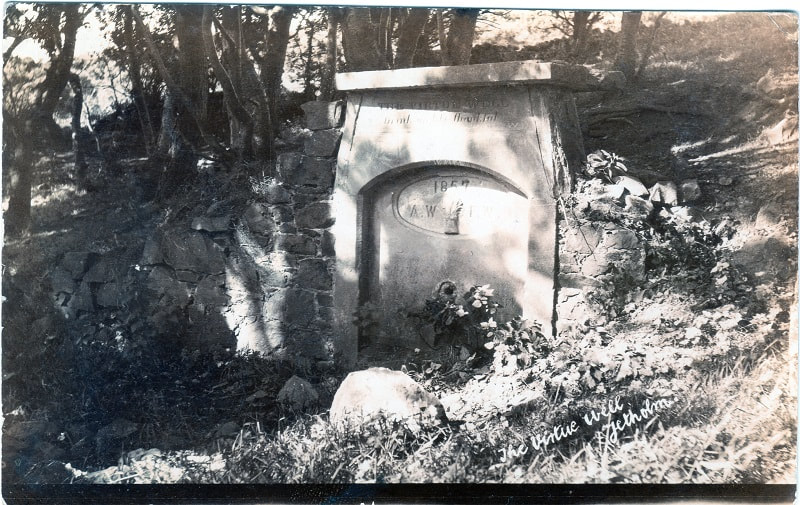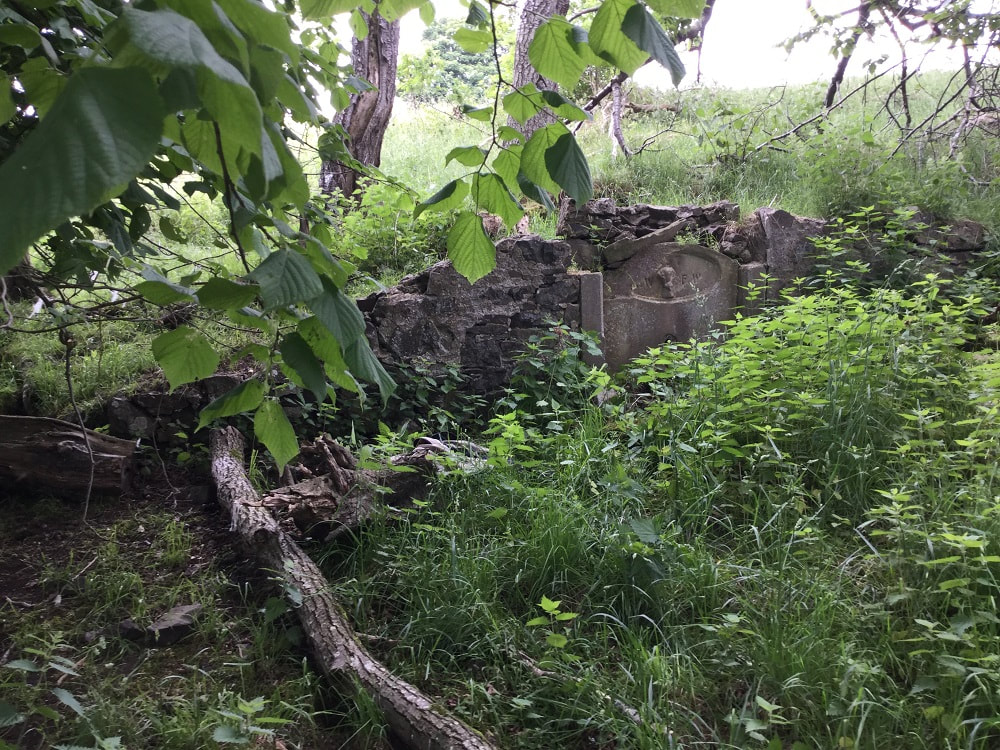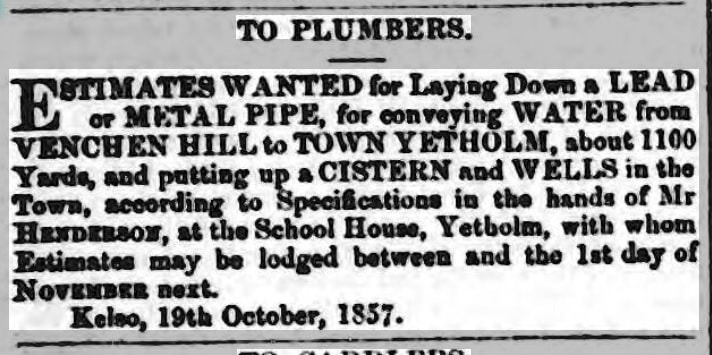|
While the coronavirus pandemic has forced the closure of all but essential business – and also meetings of Yetholm History Society! – we are still allowed an hour’s ‘essential exercise’ each day. If you are getting bored with the same daily perambulation it might be worth a trip up Venchen Hill pausing, at its foot , near the crossroads where the Cherrytrees and Wooler roads part company, to investigate the remains of the Virtue Well. There’s not much of left these days – the photograph above/top shows the well as it was in about 1913. The photograph below it shows it as it is today. It’s a pity the old well is now dry and ruinous, as the name – Virtue – suggests the water which once flowed from it had health-giving qualities.
Yetholm’s Virtue Well is not the only one in the Borders. Hawick had its ‘Verter Well’, at the bottom of Vertish Hill, on the outskirts of town. The Hawick Verter Well may have been famed for its healing qualities for centuries, but we only really know anything about it from the mid-19th century. Its properties were investigated by the Hawick Literary Scientific Institute in 1851, but they found neither traces of iron or carbonic acid gas – so maybe it’s healing qualities had already run out by then! (Kelso Chronicle 14th March 1851). Nevertheless in around 1879 the Verter Well was given a makeover, as can be seen by this letter which appeared in the Hawick Express (29th September 1879): THE VERTER WELL REPAIRED. —With your permission I have to thank the Rev. John Thomson and Mrs Thomson of Rosalee through your paper for giving me orders to cause the Verter Well to be repaired at their expense. I may say it has been rebuilt by Mr Walter Reid to my satisfaction, and it is done in a workman-like way; and I think the public will appreciate Mr and Mrs Thomson for their kindness in bringing this valuable mineral water within the reach of everyone free of charge. It is a blood-purifying mineral water, and anyone who has boils, pimples, sores, or scurvy it will cure if it is taken every day for a few weeks ; and anyone taking a drink now and again will prevent the above, and prevention is better than cure. Mrs Thomson could not have given a better gift to the inhabitants than in bringing this water within the reach of all. Someone will say, “What has been done to this well?" I may say it is rebuilt with brick and cement, and a wall built on each side of it one foot and a-half high, about six feet long, and coped with strong freestone and cement, which makes two fine seats for invalids to sit on. It is all flagged with freestone, and a drain pipe is laid under the flagstones to keep them clean and dry. Mr Walter M'Kenzie is repainting and relettering it, and it is now a place of attraction and usefulness for the above cures. Too much praise cannot be given to Mr and Mrs Thomson fur their generosity.—Yours, November 26, 1879. REUBEN WATTS. Unfortunately the Verter Well is situated immediately next to the River Teviot and very soon after the Jedburgh Gazette (3rd December 1881) reported a flood in which ‘the Teviot soon began to wax and overflow … and sept away part of the rail at the Verter’. How long people with ‘boils, pimples, sores, or scurvy’ continued to use it is unclear. By the 1950s it had gone. The Hawick Express (23rd July 1952) lamented it’s oblivion: THE VERTER WELL VANISHES - HAWICK'S old Verter Well, which had its site by the roadside on the Carlisle Road, in the vicinity of the Dunk Pool on the Teviot, has now virtually disappeared, even the iron framework surrounding it having gone the way of all scrap metal in these days. The scrap collectors could hardly be blamed, for the old Well had long had a very derelict appearance, and, of course, it has been out of use and producing no water for over half a century. But there are some of the veterans who can recall the days of its use and who often regret that some more determined effort had not been made to preserve the Well and its water, which was long ago credited with having certain curative and health-giving qualities. At least the Hawick well had its rise and fall chronicled. Yetholm’s Virtue Well is much more mysterious. We can see from the 1913 postcard that the stonework around it in was erected in 1857. The initials are those of Andrew Wauchope, the local laird (father of General Wauchope) and his wife Frances Wauchope. Between their initials is the Wauchope emblem – a sheaf of corn (which is also present of the Yetholm weaver’s banner – see HERE). What prompted this act of benefaction is unknown. It is probably no coincidence, however, that 1857 was the year in which the Heritors initiated a scheme to bring piped water from a source towards the top of the Venchen into Town Yetholm (see notice in Kelso Chronicle 23rd October 1857, below). It seems likely that the construction of the Virtue Well was an off-shoot of this project. It may have been at this date also that a grove of trees was planted around the well. It must have been a pleasant place to sit at one point. We know a little bit more about from the Yetholm Name Book, which was produced to accompany the Ordnance Survey maps of c 1860. The Rev Baird describes the Virtue Well as - A spring of beautiful clear water enclosed in handsome stonework with an iron tap, and ladle attached for the convenience of people drinking the water, cut on the stonework of the fountain is the inscription “Drink and be thankful”. And that’s about all we know of it. The date when people first started to believe in its health-giving virtues is lost in the mists of time. Was it, too, believed to cure all manner of ‘boils, pimples, sores, or scurvy’? How long it continued to flow is also unknown. In the 1950s the village dump, surrounded by a green corrugated fence, was located nearby. At least that has been removed – but the well itself is neglected and will soon also have completely disappeared.
25 Comments
|
Archives
July 2024
|



 RSS Feed
RSS Feed
